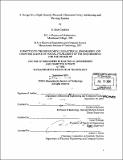| dc.contributor.advisor | Kullervo Hynynen and James Roberge. | en_US |
| dc.contributor.author | Caulfield, Russell Erich, 1975- | en_US |
| dc.contributor.other | Massachusetts Institute of Technology. Dept. of Electrical Engineering and Computer Science. | en_US |
| dc.date.accessioned | 2008-01-10T17:26:58Z | |
| dc.date.available | 2008-01-10T17:26:58Z | |
| dc.date.copyright | 2005 | en_US |
| dc.date.issued | 2006 | en_US |
| dc.identifier.uri | http://dspace.mit.edu/handle/1721.1/35526 | en_US |
| dc.identifier.uri | http://hdl.handle.net/1721.1/35526 | |
| dc.description | Thesis (Ph. D.)--Massachusetts Institute of Technology, Dept. of Electrical Engineering and Computer Science, February 2006. | en_US |
| dc.description | Includes bibliographical references (p. 124-137). | en_US |
| dc.description.abstract | The feasibility of using focused ultrasound as an effective means of destroying malignant and benign tumors has been demonstrated in numerous studies. Research into methods for delivering the energy used in therapeutic applications has primarily used multi-element arrays, with phased array techniques offering the most flexibility. While these methods have proven effective in the ablation of tumors in vivo, limitations exist in several areas, which have prevented further advances from being made. In order to achieve tighter control over focal volume and increase beam steering capabilities, the number of elements used in phase array design will have to be increased. However, issues related to cost, matching, interconnects and cable assembly size have prevented high-density arrays from being realized as a practical means for treatment. The goal of this research was to demonstrate the feasibility of designing and testing a relatively low-cost system that could effectively drive several thousand elements, while minimizing the size of the cable assembly that delivers power to the array. | en_US |
| dc.description.abstract | (cont.) Use was made of flexible circuit technology as well as a novel method for addressing each channel. An investigation of a new technique for phase assignment in phased array configurations was also conducted to determine an optimal balance between the number of input lines and the quality of beam steering and focus control. | en_US |
| dc.description.statementofresponsibility | by R. Erich Caulfield. | en_US |
| dc.format.extent | 135 p. | en_US |
| dc.language.iso | eng | en_US |
| dc.publisher | Massachusetts Institute of Technology | en_US |
| dc.rights | M.I.T. theses are protected by copyright. They may be viewed from this source for any purpose, but reproduction or distribution in any format is prohibited without written permission. See provided URL for inquiries about permission. | en_US |
| dc.rights.uri | http://dspace.mit.edu/handle/1721.1/35526 | en_US |
| dc.rights.uri | http://dspace.mit.edu/handle/1721.1/7582 | |
| dc.subject | Electrical Engineering and Computer Science. | en_US |
| dc.title | A design for a high-density focused ultrasound array addressing and driving system | en_US |
| dc.type | Thesis | en_US |
| dc.description.degree | Ph.D. | en_US |
| dc.contributor.department | Massachusetts Institute of Technology. Department of Electrical Engineering and Computer Science | |
| dc.identifier.oclc | 72676869 | en_US |
